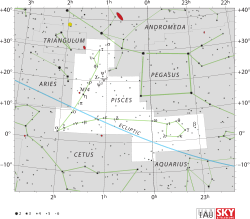Chi Piscium
Chi Piscium (χ Piscium) is a solitary,[9] orange-hued star in the zodiac constellation of Pisces. It can be seen with the naked eye, having an apparent visual magnitude of +4.64.[2] Based upon an annual parallax shift of 8.50 mas as seen from Earth,[1] it is located about 384 light years from the Sun.
 | |
| Observation data Epoch J2000.0 Equinox J2000.0 (ICRS) | |
|---|---|
| Constellation | Pisces |
| Right ascension | 01h 11m 27.21877s[1] |
| Declination | +21° 02′ 04.7406″[1] |
| Apparent magnitude (V) | +4.64[2] |
| Characteristics | |
| Spectral type | G8.5 III[3] |
| U−B color index | +0.83[2] |
| B−V color index | +1.02[2] |
| Astrometry | |
| Radial velocity (Rv) | +15.04±0.21[4] km/s |
| Proper motion (μ) | RA: +39.32[1] mas/yr Dec.: −10.48[1] mas/yr |
| Parallax (π) | 8.50 ± 0.21[1] mas |
| Distance | 384 ± 9 ly (118 ± 3 pc) |
| Absolute magnitude (MV) | −1.13[5] |
| Details[6] | |
| Mass | 3.17±0.23 M☉ |
| Radius | 20.65±0.57 R☉ |
| Luminosity | 209.2±10.5 L☉ |
| Surface gravity (log g) | 2.33±0.05 cgs |
| Temperature | 4,835±28 K |
| Metallicity [Fe/H] | −0.15±0.10 dex |
| Rotational velocity (v sin i) | 10[7] km/s |
| Age | 380±100 Myr |
| Other designations | |
| Database references | |
| SIMBAD | data |
This is an evolved G-type giant star with a stellar classification of G8.5 III.[3] There is a 94%[6] chance that it is on the horizontal branch and is a red clump star,[10] which means it is generating energy through helium fusion at its core. Chi Piscium is estimated to have 3.17 times the mass of the Sun, nearly 21 times the solar radius, and shines with 209 times the Sun's luminosity. It is around 380 million years old.[6]
Naming
In Chinese, 奎宿 (Kuí Sù), meaning Legs (asterism), refers to an asterism consisting of χ Piscium, η Andromedae, 65 Piscium, ζ Andromedae, ε Andromedae, δ Andromedae, π Andromedae, ν Andromedae, μ Andromedae, β Andromedae, σ Piscium, τ Piscium, 91 Piscium, υ Piscium, φ Piscium and ψ¹ Piscium. Consequently, the Chinese name for χ Piscium itself is 奎宿十五 (Kuí Sù shíwǔ, English: the Fifteenth Star of Legs.)[11]
References
- van Leeuwen, F. (2007), "Validation of the new Hipparcos reduction", Astronomy and Astrophysics, 474 (2): 653–664, arXiv:0708.1752, Bibcode:2007A&A...474..653V, doi:10.1051/0004-6361:20078357.
- Argue, A. N. (1966), "UBV photometry of 550 F, G and K type stars", Monthly Notices of the Royal Astronomical Society, 133: 475–493, Bibcode:1966MNRAS.133..475A, doi:10.1093/mnras/133.4.475.
- Keenan, Philip C.; McNeil, Raymond C. (1989). "The Perkins catalog of revised MK types for the cooler stars". Astrophysical Journal Supplement Series. 71: 245. Bibcode:1989ApJS...71..245K. doi:10.1086/191373.
- de Bruijne, J. H. J.; Eilers, A.-C. (October 2012), "Radial velocities for the HIPPARCOS-Gaia Hundred-Thousand-Proper-Motion project", Astronomy & Astrophysics, 546: 14, arXiv:1208.3048, Bibcode:2012A&A...546A..61D, doi:10.1051/0004-6361/201219219, A61.
- Takeda, Yoichi; Sato, Bun'ei; Murata, Daisuke (August 2008), "Stellar Parameters and Elemental Abundances of Late-G Giants", Publications of the Astronomical Society of Japan, 60 (4): 781–802, arXiv:0805.2434, Bibcode:2008PASJ...60..781T, doi:10.1093/pasj/60.4.781.
- Reffert, Sabine; et al. (2015), "Precise radial velocities of giant stars. VII. Occurrence rate of giant extrasolar planets as a function of mass and metallicity", Astronomy & Astrophysics, 574: A116, arXiv:1412.4634, Bibcode:2015A&A...574A.116R, doi:10.1051/0004-6361/201322360. Values are for the slightly higher probability horizontal branch model fit.
- Bernacca, P. L.; Perinotto, M. (1970), "A catalogue of stellar rotational velocities", Contributi Osservatorio Astronomico di Padova in Asiago, 239 (1), Bibcode:1970CoAsi.239....1B.
- "chi Psc". SIMBAD. Centre de données astronomiques de Strasbourg. Retrieved 2017-07-23.
- Eggleton, P. P.; Tokovinin, A. A. (September 2008), "A catalogue of multiplicity among bright stellar systems", Monthly Notices of the Royal Astronomical Society, 389 (2): 869–879, arXiv:0806.2878, Bibcode:2008MNRAS.389..869E, doi:10.1111/j.1365-2966.2008.13596.x.
- Valentini, M.; Munari, U. (November 2010), "A spectroscopic survey of faint, high-Galactic-latitude red clump stars. I. The high resolution sample", Astronomy and Astrophysics, 522: A79, arXiv:1007.0207, Bibcode:2010A&A...522A..79V, doi:10.1051/0004-6361/201014870.
- (in Chinese) AEEA (Activities of Exhibition and Education in Astronomy) 天文教育資訊網 2006 年 5 月 19 日